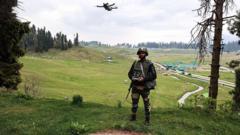As both nations navigate a rising drone warfare strategy, experts warn of a shifting balance in their military dynamics, with the potential for either de-escalation or heightened conflict looming.**
Escalation in India-Pakistan Tensions: A New Era of Drone Warfare**

Escalation in India-Pakistan Tensions: A New Era of Drone Warfare**
A recent exchange of drone strikes between India and Pakistan signifies a troubling development in long-standing regional conflicts, raising concerns over potential escalation.**
The India-Pakistan rivalry has entered an unprecedented phase as the two nuclear-armed nations engage in a series of drone attacks. Recent allegations have emerged from India that Pakistan launched drone and missile strikes on key military installations within Indian territory and Kashmir, allegations that Pakistan has firmly rejected. In contrast, Pakistani military officials claim to have downed 25 Indian drones, a claim that has gone unacknowledged by Indian authorities.
Experts assert that this drone warfare introduces a perilous chapter in the extended conflict between the two neighbors, whereby unmanned aerial vehicles (UAVs) are exchanged across a fraught border. "The India-Pakistan conflict is evolving into a drone era," commented Jahara Matisek, a military strategist. He emphasized that success in drone warfare may redefine battlefield dynamics in this contested region.
In recent military exchanges, Pakistani sources cite that Indian offensives have led to significant casualties—36 lives lost and numerous injuries resulting from artillery strikes, while India alleges similar casualties on their side from Pakistani actions. These aggressive tactics are steeped in historical grievances, with recent retaliatory strikes being linked to a militant attack in Kashmir that both countries attribute to the other.
The drone capabilities on both sides are notable and diverse. India's array of drones includes Israeli-designed UAVs, capable of reconnaissance and targeted strikes, alongside a recent $4 billion deal with the US for advanced MQ-9B Predator drones. Conversely, Pakistan boasts a robust mix of indigenous and imported drones, including Chinese and Turkish models, significantly bolstering its military operations.
While drones are revolutionizing modern military engagements globally, experts caution that the current exchanges between India and Pakistan appear more symbolic than strategic compared to the extensive UAV operations seen in the Russia-Ukraine conflict. Analysts suggest that these drone incidents may be tactical responses rather than the precursor to a broader aerial campaign.
The rise of drone warfare complicates traditional military strategies, providing options that minimize direct conflict but simultaneously increase the risk of escalation. As both nations refine their military tactics with drones, the situation remains volatile, underscoring a precarious balance where every drone encounter could ignite further conflict.
India's ongoing embrace of UAV technology signals a pivotal shift in how military confrontations could unfold, potentially reshaping power dynamics in the region. Nonetheless, as emphasized by experts, while drones might offer tactical advantages, their increasing presence introduces new risks, and both countries find themselves at a critical juncture in determining future stability or conflict.



















